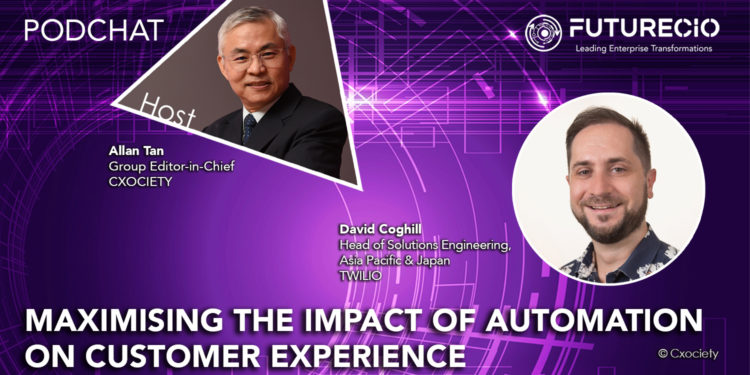In a Forrester study commissioned by CINNOX, only 16% of all surveyed customers recently experienced interactions that exceeded their expectations. It indicates that although organisations are committed to becoming more customer-focused, they have insufficient understanding of customers’ expectations and are failing to deliver quality experiences.
In more developed markets like Hong Kong and Singapore, customer experience sentiments were the lowest, with only 7% and 9% (respectively) experiencing interactions that exceeded their expectations, respectively.
Patsy Wong, during her stint as chief strategy officer at CINNOX, was quoted as saying customer experience is the battleground that organisations compete on.
A different world
David Coghill, head of solutions engineering for Asia Pacific & Japan at Twilio, acknowledges that the customer experience and customer service pre-pandemic are very different from what we understand these today.

He noted that more than 50% of all customer engagements, whether it is customer experience related or specifically in customer service, are now digital. Following the pandemic, organisations had to transform incredibly rapidly to catch up to where their consumers are.
"Customer expectations of brands have also evolved massively. In Singapore, more than 75% of brands think that they are delivering a personalised experience for their customers. In reality, less than 50% of customers agree. Brands that invest in personalisation see massive ROI. In Singapore alone, more than 97% of brands have said there is a positive ROI in investing in a more personalised customer experience," he added.
Blending automation into customer experience
A Forrester 2022 prediction says the convergence of RPA, integration platform-as-a-service, and DPA/low-code on the supply side will result in organisations embracing an automation fabric to develop an innovation culture, create business models, take new products and services to market, or rethink their customer experience.
This last part, says this is already happening. He draws on the example of Chope, a Singapore-headquartered real-time restaurant-reservation booking platform. To achieve this real-time capability, Chope connects its automated interactive voice response booking system to Twilio's platform.
He acknowledges that not everyone gets into the automation journey without a hitch. But it doesn't have to end when things break down.
"For key touchpoints where things may go wrong, we can also augment human interaction with automation. For example, we put the right channels in place for customer service agents to communicate on the channels customers prefer, whether it's phone or email. We can serve up data to agents so they can provide a more personalised experience. Automation can make things more streamlined and deliver additional value to customers," he continued.
Who's the boss?
Deciding on the approach, be it through technology, process or people or a combination thereof. Gartner cautions service and support leaders should understand these three benefits to thoroughly develop and track the right metrics for evaluating their solutions’ effectiveness and prove business cases for further investment.
Coghill says when it comes to customer service experience, there are three major stakeholders: the customer, the Chief Customer Officer of the business, and the development team. "We're increasingly seeing the rise of the Chief Customer Officer in businesses, who oversees designing what we want our customers to experience when engaging with our brand," he explained.
He goes on to add that one goal is to create the dream triangle between customers, Chief Customer Officers, and the development teams, to achieve and deliver on customer service outcomes.
Measure, measure, measure
It is a widely accepted maxim that a customer who is satisfied with the service quality, user experience, and brand preferences will stay with the company. Fortunately (or unfortunately) there are several metrics for measuring customer experience: Customer Effort Score (CES), Customer Satisfaction (CSAT), Net Promoter Score (NPS), Customer Retention Rate, Customer Churn Rate, First Contact Resolution (FCR), Average Resolution Time (ART) and Customer Referral Rate to name a few.
Coghill acknowledges these metrics and ads that "we're seeing more transformed organisations start to think more about things like customer satisfaction – how are the customers feeling at the end of this transaction?"
One last advice
Asked what his advice is for leaders looking for a more effective and efficient customer service operation, Coghill offers two:
"Firstly, make sure that you're focused on the right thing. What do your customers want? What are the outcomes that they're trying to achieve?
"The second is that customer experience is a differentiator. One of the major transformations that are happening right now is that it’s no longer a one-size-fits-all world. How do you create that truly personalised experience not just for your customer, but for also fits what you want to accomplish with your brand?" he concluded.
Click on the PodChat player to listen in on Coghill's views and recommendations on maximising the impact of automation on customer experience.
1. Give us a state of customer service today – what is working and what isn’t?
2. Some automation already exists in today’s customer service. Where are the major failings of these automation tools/processes?
3. Given that technology is an enabler for customer service (do you agree with this statement?), who decides what technologies should be integrated into the process?
4. What metrics should be used to evaluate the effectiveness of such an effort?
5. Can you cite any use case today where automation has proven to be an effective approach to enhancing customer service?
6. What is your advice to leaders looking for a more effective and efficient customer service operation?
7. What sort-of investments am I looking at when evaluating how to transform my processes to be more customer-centric?





